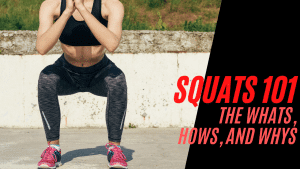Are dumbbell reverse lunges better than forward lunges?
When people think of lower body exercises, squats are probably the most common that come to mind, with lunges coming in second. But most of the time, lunges are associated with forward movements. And while it is not entirely wrong, there are also a few other lunge variations that require you to move in other directions.
One of them is the dumbbell reverse lunge. It is a more challenging yet safer and beginner-friendly alternative, but for whatever reason, it does not get as much love as the regular lunge.
But just how effective is the dumbbell reverse lunge? Does stepping and bending your knees backward make any difference? Will the dumbbells help in any way?
Keep scrolling to find out.
What is a dumbbell reverse lunge?
Simply put, the dumbbell reverse lunge is a knee-dominant unilateral leg strengthening exercise that requires you to hold a pair of dumbbells while you bend your knee backward.
But while this particular version of the lunge is a great exercise for the legs, overall lower body strength is best achieved by mastering all variations of the lunge. However, since the regular forward lunge is not exactly easy, this slightly less challenging variation is the best way to start your lunge progression.
The dumbbell reverse lunge hits the same major muscle groups as the other forms of the lunge, but what makes it a little better than the forward lunge is that it can work the glutes, hamstrings, quads, and calves without putting too much stress on the knee joints.
In a forward lunge, deceleration takes place once your front foot lands to stop the forward movement which can put undue strain on the patella tendon. However, since the movement of the dumbbell reverse lunge is in the opposite direction, the decelerating force is taken off the patella tendon, allowing you to focus more on the muscles you are training instead of the inevitable knee pain that comes with a forward lunge.
Moreover, it is easy to overstep and get your weight in the wrong position during a forward lunge. But if you perform a reverse lunge, the movement naturally brings your weight over the front heel which is where it should be.
Adding a pair of dumbbells simply increases the difficulty of the reverse lunge. But even though the extra weights make the exercise more challenging, they do not make it any less safe. If anything, going heavy and gradually increasing the weight you use will be much easier with reverse lunges since they provide more stability than the forward lunge.
How to do the dumbbell reverse lunge
1. Begin by standing with your feet shoulder-width apart.
2. Place your arms on the sides while holding a dumbbell in each hand.
3. Brace your core then take a big step backward with one leg.
4. Let both your knees bend at the same time to lower yourself deep enough that both your legs are at a 90-degree angle. If you feel that you can still go lower, try and do so until your knee is in contact with the ground.
5. Return to the starting position by driving through the front foot and extending your knee as you stand up.
6. Perform 4 sets of 8 reps each on one leg then move on to the other side once you are done.
Tips for a successful dumbbell reverse lunge
• Avoid rushing the progression scheme. The reverse lunge may be a bit easier than the forward lunge but it is still an advanced leg exercise by itself, so adding weights to it will make it even more challenging. That said, make sure you are strong enough before doing this exercise because if you still lack the needed hip and core stability, you are only setting yourself up for injury.
• Do not use weights that are too heavy. While using weights are relatively easier in a reverse lunge, too much of it can still compromise your form and movement which can make the exercise less effective.
• When you push back up to return to the starting position, avoid recruiting your shoulders via hyperextension of your spine to initiate the movement. Use the force from your lower body to drive the movement instead.
• Make sure that both your legs are at a 90-degree angle at the knees once you reach the bottom of the movement.
• Take a larger step than usual by driving up through the heel if you want to put more emphasis on the glutes and hamstrings.
• Focus on the safety and health of your knees by making sure that the knee and toes of your back leg are facing the same direction throughout the exercise. Keep your back leg fully bent during the lunge too. Failure to do so will cause a strain in your hips which can make lowering your body painful and difficult.
• If you are struggling with stability at first, try doing the exercise next to a wall or a sturdy bar first. This will give you enough support as you lower and raise until you finally master the proper form and movement.
The benefits of performing a reverse lunge
Stronger posterior chain
Since reverse lunges work the glutes and hamstrings, they are essentially strengthening and toning your entire backside. It also trains the knee to stabilize itself over the toe. And speaking of knees, reverse lunges are easier on them too because the backward step makes shearing of the joints less likely.
Improved mobility
One of the main causes of knee pain is the lack of ankle mobility, while lower back pain is typically a result of limited hip mobility. With reverse lunges, you avoid such problems by improving your range of motion which will eventually translate to better overall mobility. In other words, doing this exercise is essentially improving your quality of life.
Forward lunges vs. reverse lunges
Both the forward and reverse lunges are great exercises for strengthening the legs. As you get older, muscle imbalances on the right and left sides of your body may lead to serious pain and injury. This is because some muscles work more than they should to compensate for an imbalance in another related muscle. As a result, the risk of injury in those overworked muscles increases.
However, with single-leg exercises like the forward and reverse lunge, you can easily determine and correct any muscle imbalance you may have on either side of your body.
But while these lunges are both helpful, there are also a few differences that make the reverse lunge slightly better than the forward lunge.
The number one thing that makes the reverse lunge more ideal is the fact that it requires less stability than a forward lunge, making it more beginner-friendly.
This is because, in a forward lunge, the leg you step forward is the main driver of force which means that the glutes, hamstrings, and quadriceps must be activated so you can decelerate then push back up to the starting position.
In a reverse lunge, the movement is easier to control because the stationary leg is the main driver of force.
Reverse lunges are also relatively safer because it is easier to push through your heel. Such action is more effective in activating the muscles at the back of your body, more collectively known as the posterior chain.
With forward lunges, there is more stress placed on the knee which is even more exacerbated as you go lower. This is because lunging this way puts the pressure on the toes or the ball of the foot, instead of the heel.
More lunge variations for stronger legs
Forward lunge
Start this exercise by retracting your shoulders, tightening your core, and standing with your feet together. Raise your right leg and take a big step forward. Bend your right knee to lower your body until it forms a 90-degree angle with your right thigh parallel to the ground. Push through your right heel to return to the starting position. Repeat according to your desired number of reps then perform the exercise with the other leg.
Clock lunge
This version of the lunge is a combination of other lunge variations. Start by doing a forward lunge then standing back up to return to the starting position. After that movement, perform a lateral lunge then go back to standing. Lastly, execute a reverse lunge then stand back up. Repeat according to your desired number of reps then do the exercise on the other side.
Lateral lunge
Begin by engaging your core and standing with your feet hip-width apart. Take a big step to the right then bend one of your knees, making sure that it does not go past your toes. Lower your hips but keep the other leg straight with both your feet firmly planted on the ground. Stand up to return to the starting position then perform the exercise on the other side.
Curtsy lunge
Get into a standing position with your feet hip-width apart. Take a big step backward with one leg and cross it behind the other leg. Then bend both your knees to lower your body until the front knee forms a 90-degree angle. Push yourself back up to the starting position then repeat according to your desired number of reps before doing the exercise on the other side.



